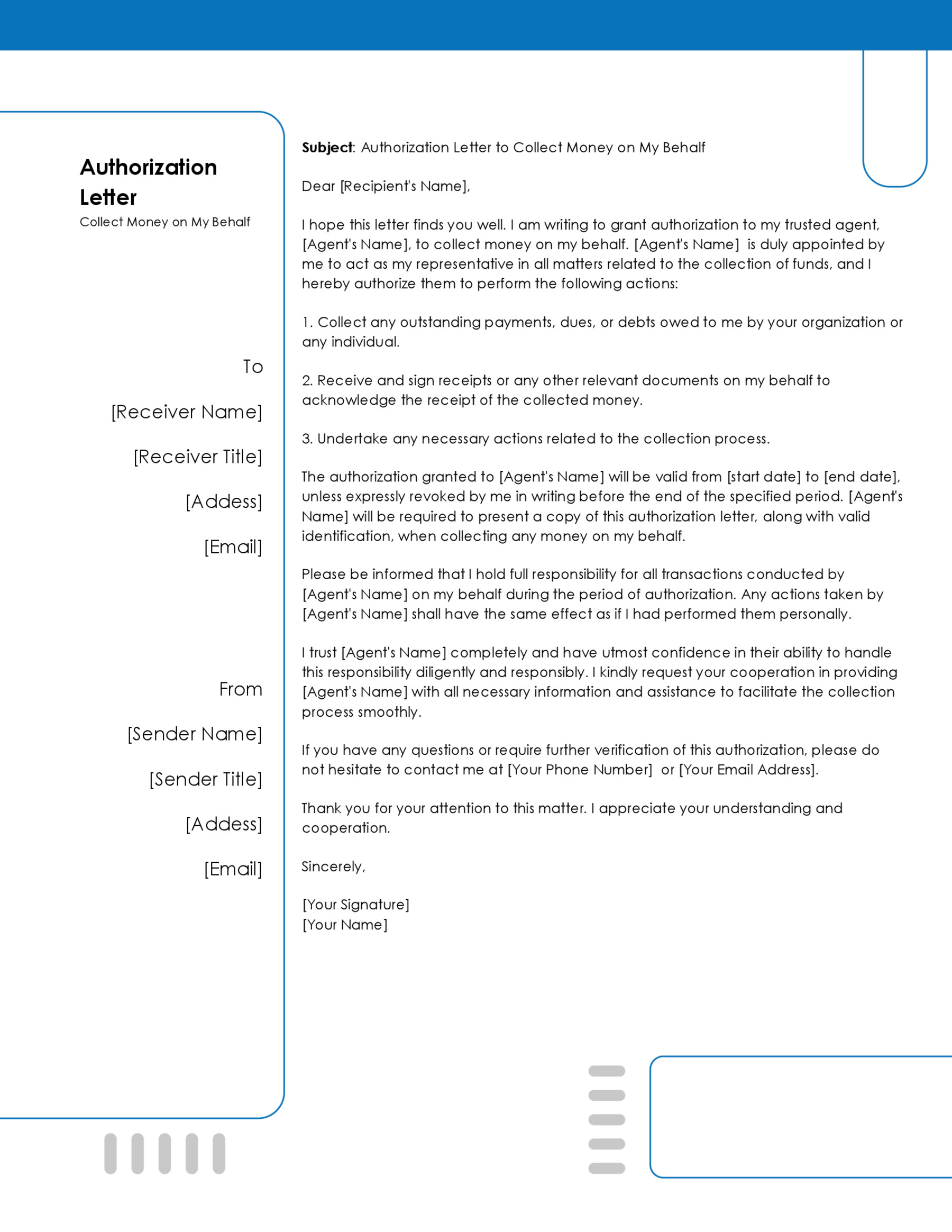Sometimes, as a parent or legal guardian, you may be unavailable to make vital medical decisions regarding your dependents or loved ones during emergencies. However, you can ensure they receive proper or needed care at the right time, even in your absence, through an authorization letter. The letter serves as a formal document you use to designate the authority to make medical decisions for a person to another individual or entity.
As the party granting the authority, you are referred to as the “principal,” while the party you appoint is called the “agent”. Typically, you will use this letter if you are the legal guardian, primary caregiver, or parent of the patient. It holds legal significance and serves as tangible evidence of the transfer of authority.
This article will educate you on how a letter of authority for medical treatment works to fulfill its purpose. To do so, it discusses the letter’s importance, the process of drafting it, and the essential legal considerations that should be taken into account during this process.
Understanding the Authorization Letter for Medical Treatment
The letter establishes a clear understanding among the principal, the agent, and the recipient. It clarifies how medical decisions and treatments for the specified individual should be managed when the principal is unavailable. Therefore, the recipient of the letter can be a healthcare provider, medical facility, or any relevant entity involved in administering medical care. Conversely, the agent can be a family member, spouse, caregiver, or friend. Moreover, the letter may contain specific instructions regarding how the principal would like particular medical situations handled.
The authority conveyed to the agent allows them to make crucial medical decisions and supervise treatments on behalf of the principal. This helps prevent any potential confusion or misunderstandings about whether the agent has the legal authority to undertake their designated responsibilities.
Issuing the letter of authority for medical treatment demonstrates the principal’s trust and confidence in the appointed agent. Therefore, it is the principal’s responsibility to choose a trustworthy agent to ensure that medical procedures and decisions align with the patient’s best interests.
Importance of Such Letters in Healthcare
In essence, medical authorization letters facilitate effective communication, decision-making, and access to medical care for a loved one when you are unavailable or incapacitated. Such letters provide a legal framework for delegating decision-making authority to someone else. This is particularly useful when healthcare providers require consent before performing any medical procedure or administering treatment in critical situations.
Additionally, this letter allows the agent to make timely and well-informed decisions during emergencies and when you are not available. Consequently, this expedites the treatment process, ultimately leading to improved healthcare outcomes and, in some cases, even life-saving interventions.
Sample Letter Templates
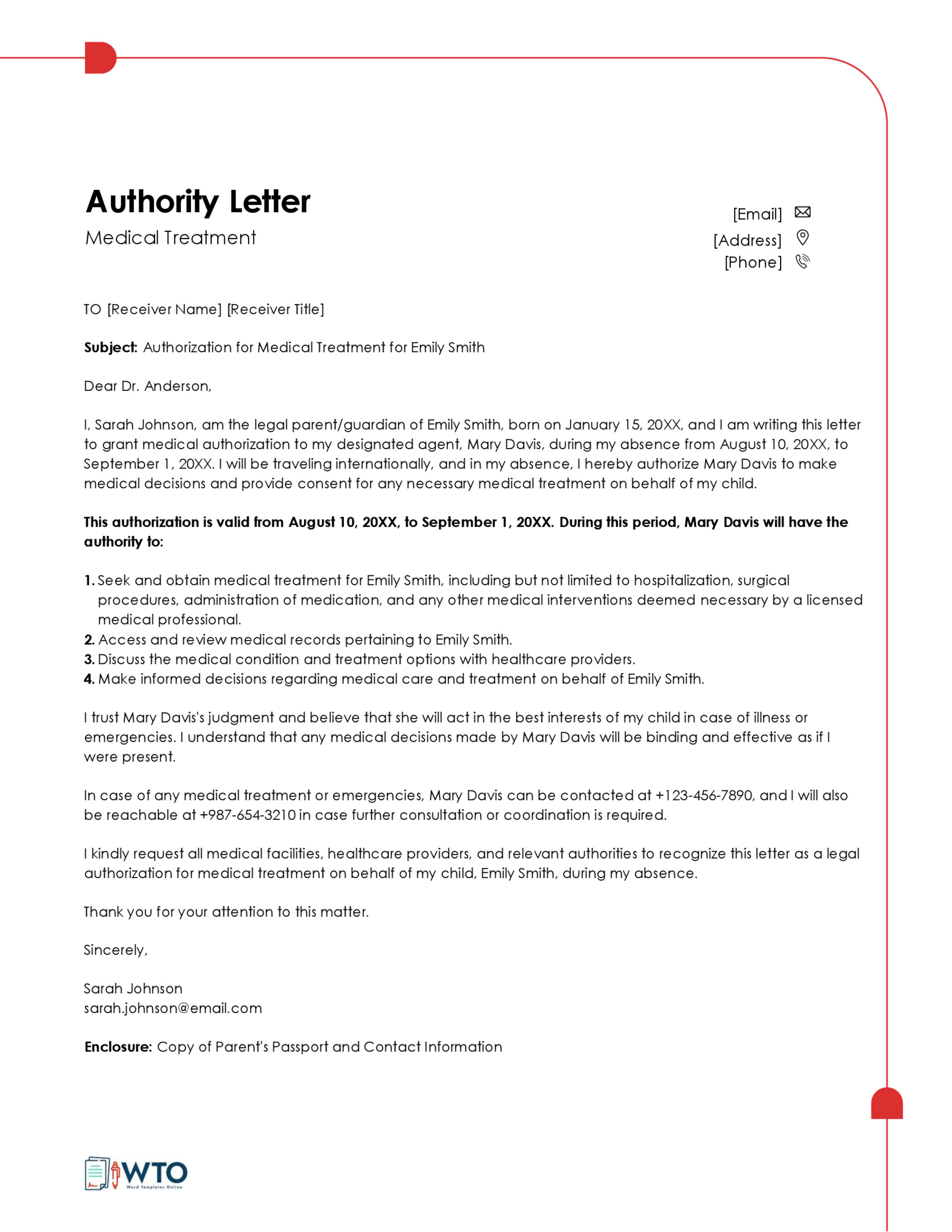
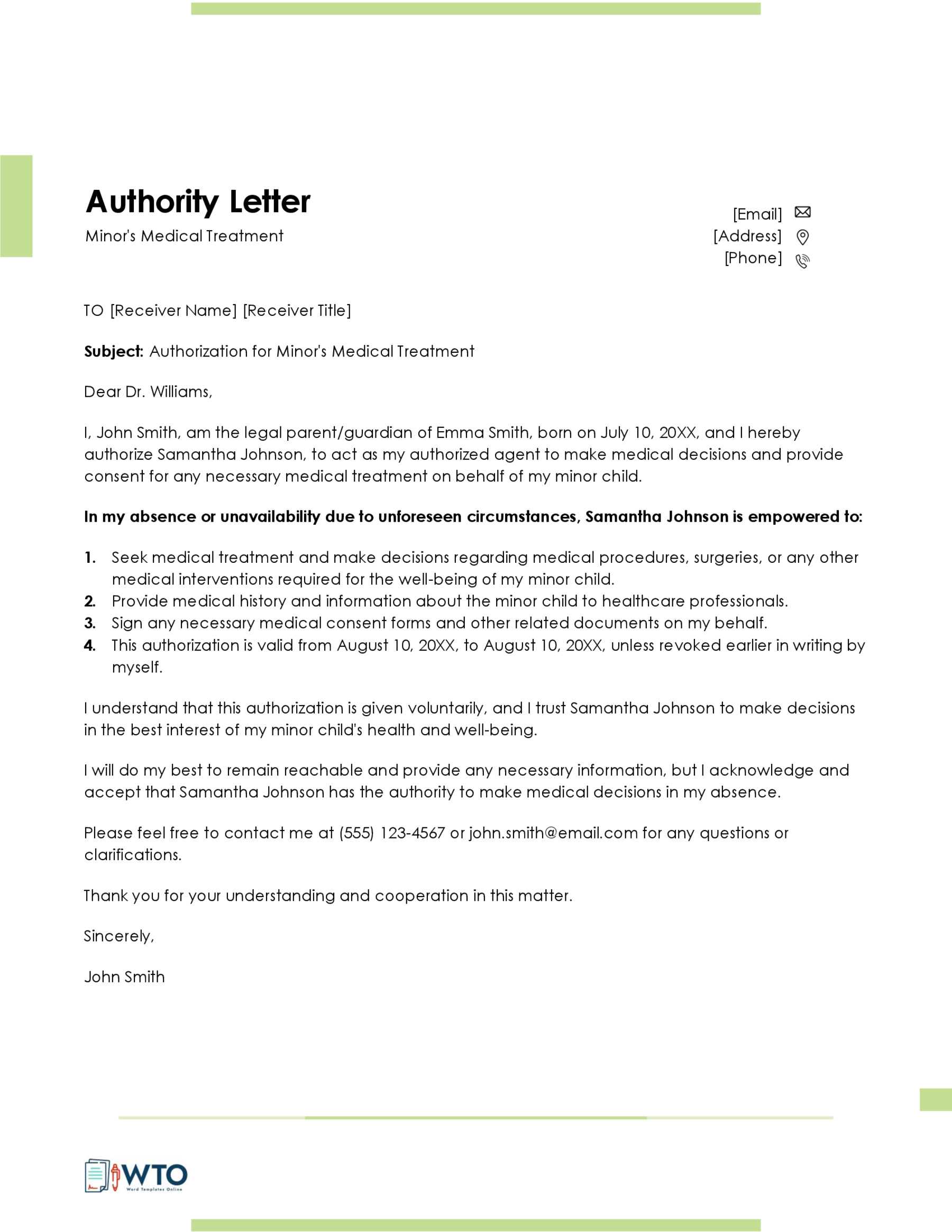
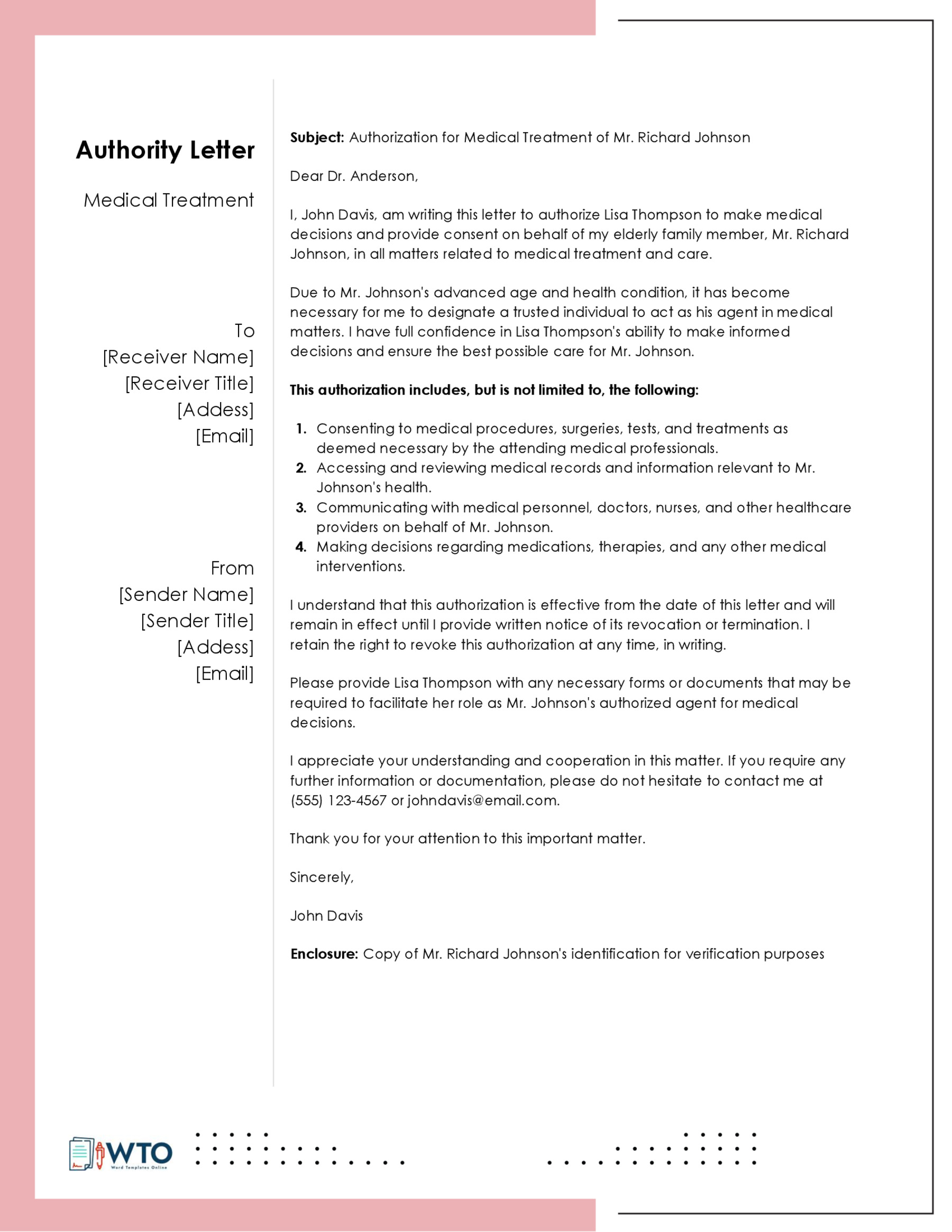
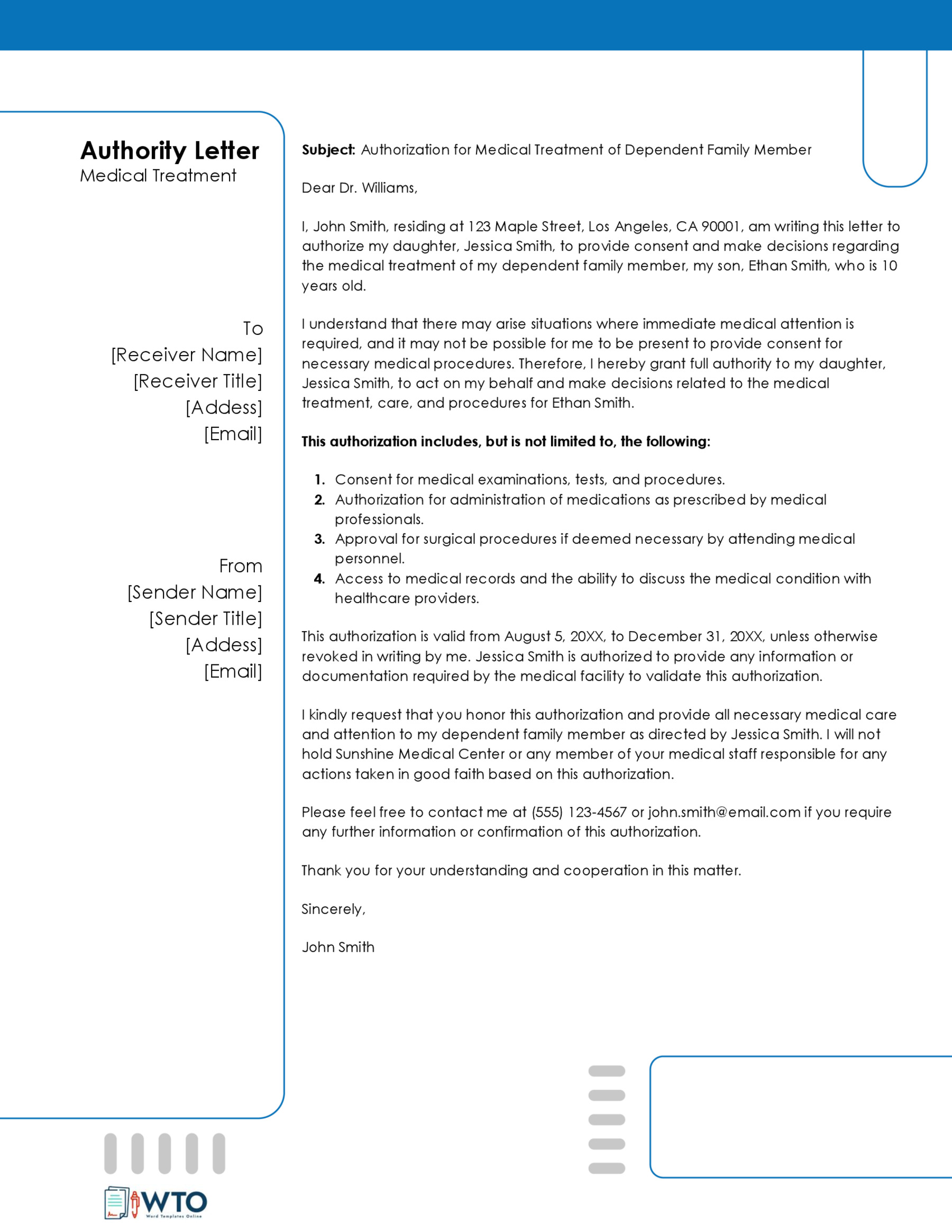
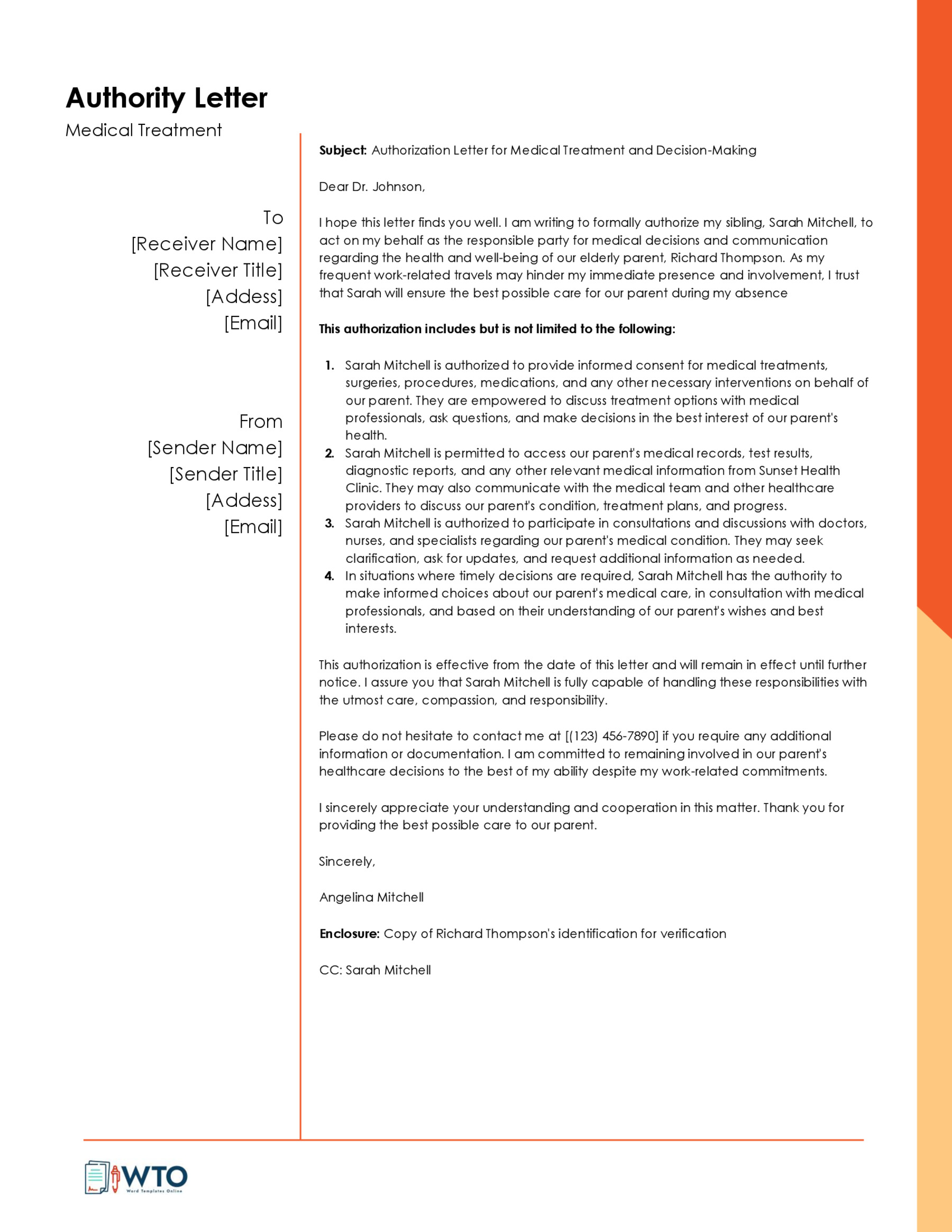
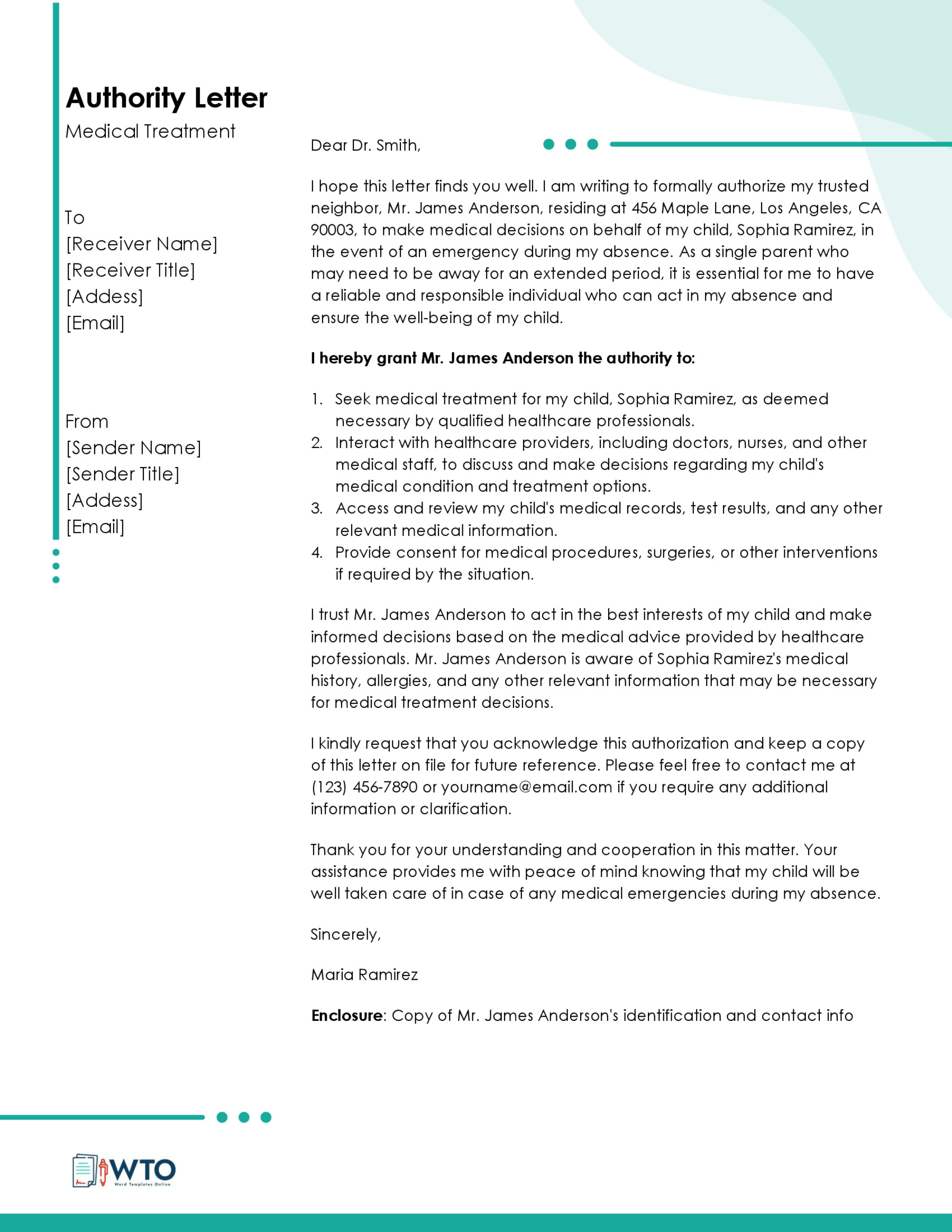
Authorization Letter Templates
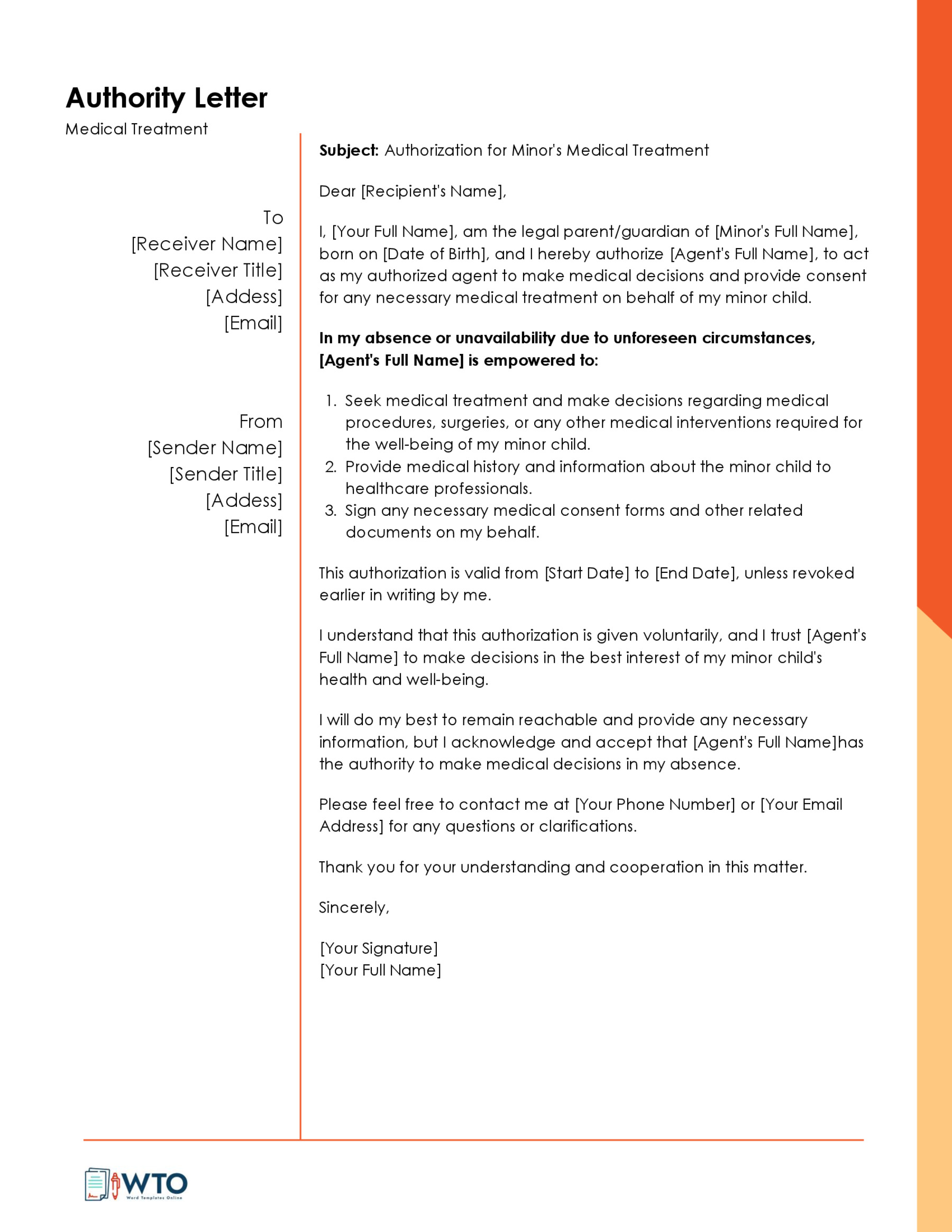
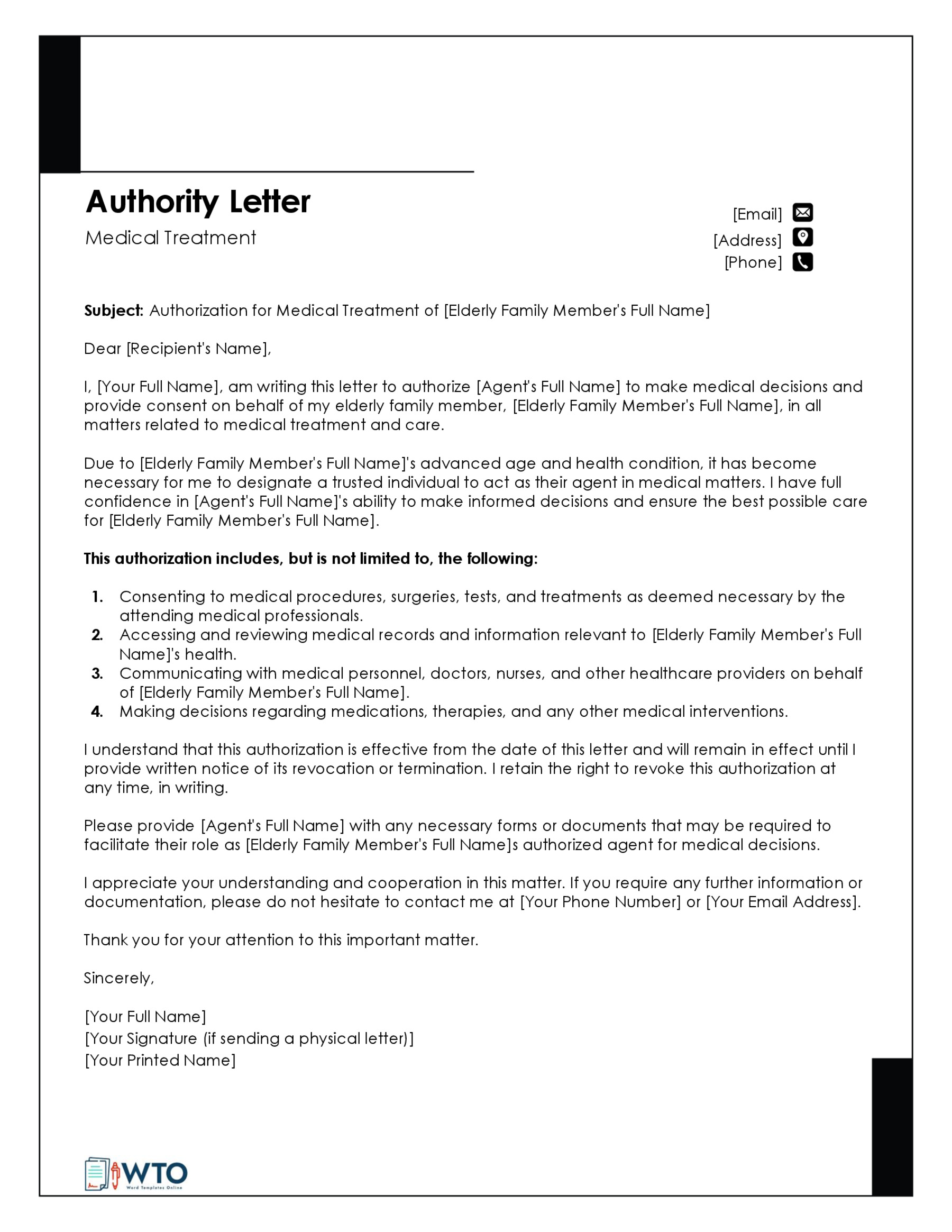
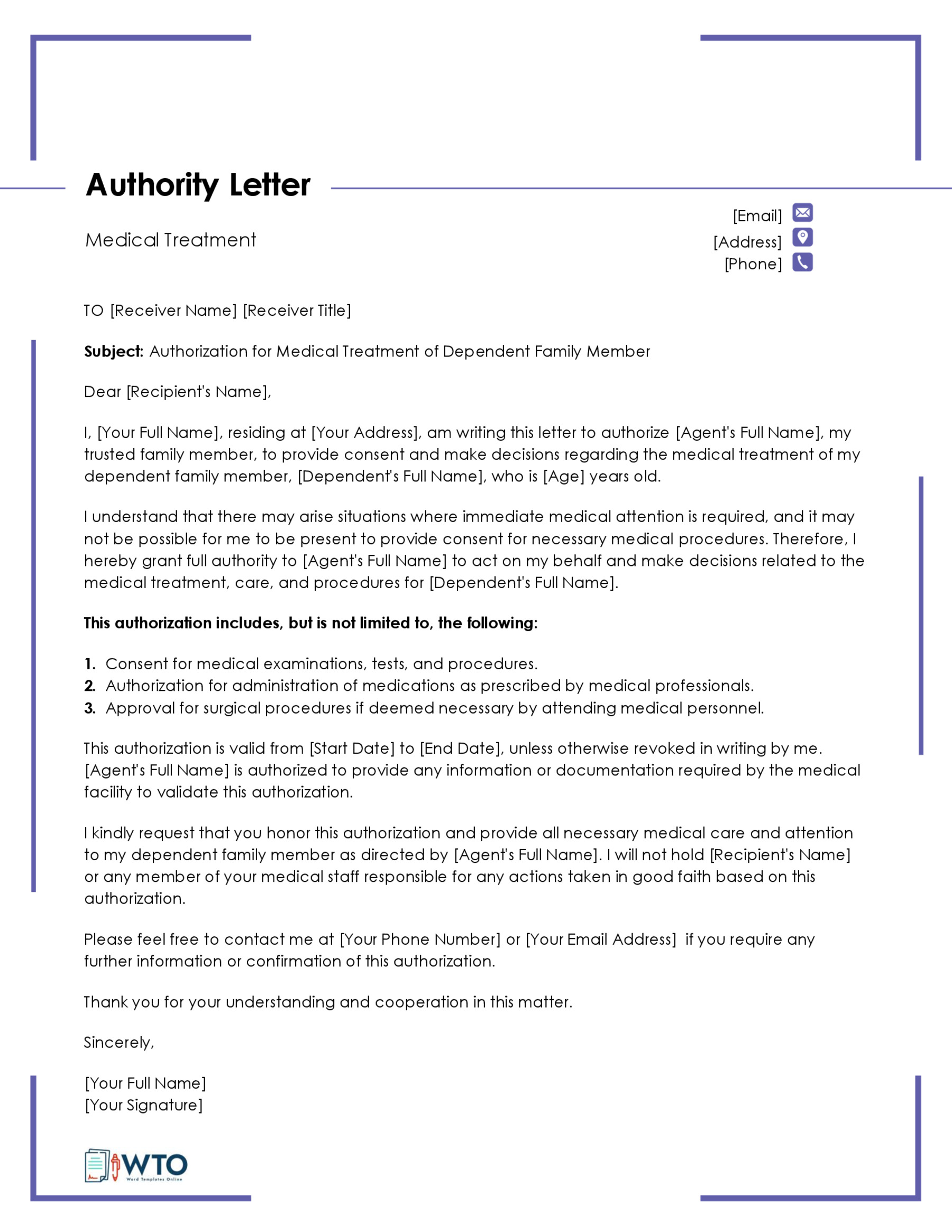
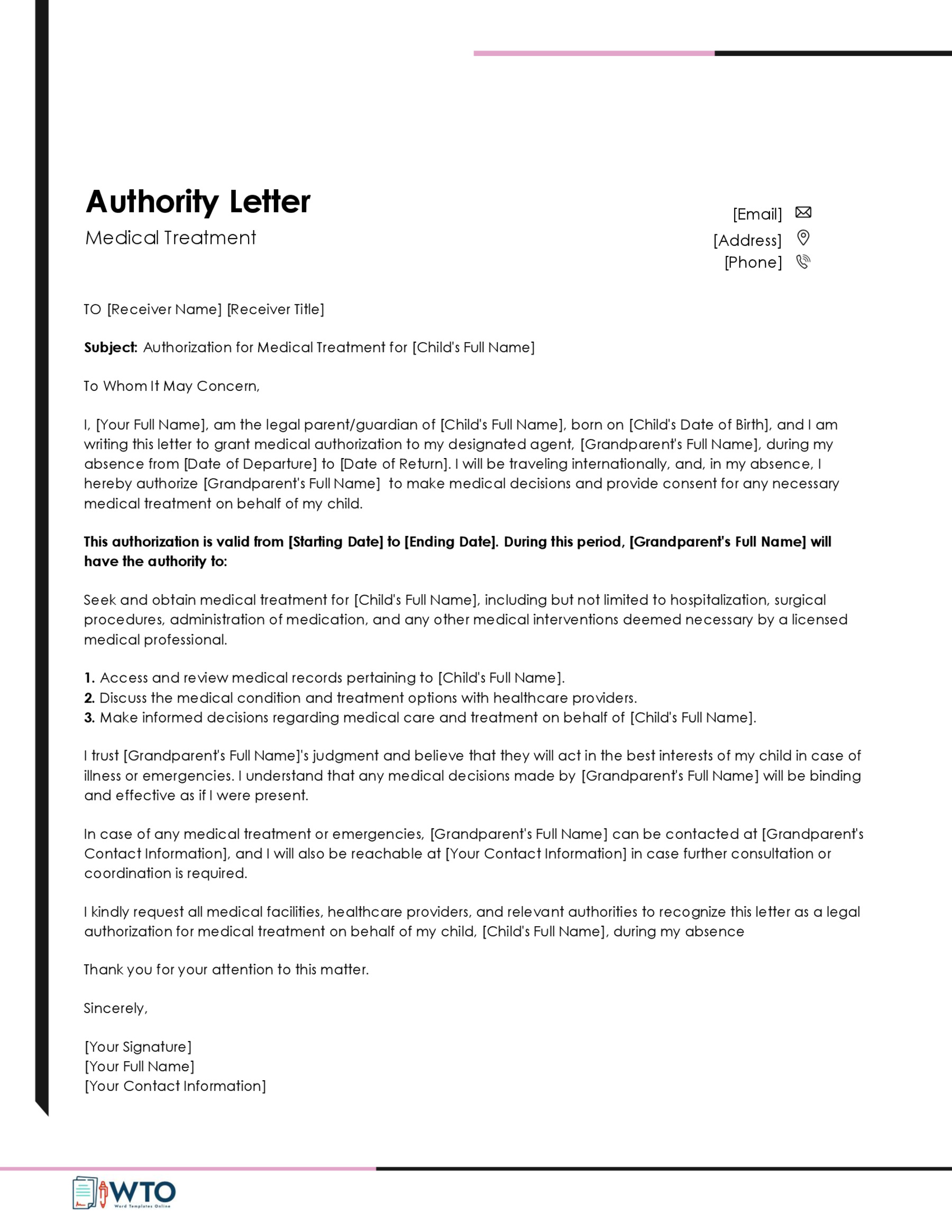
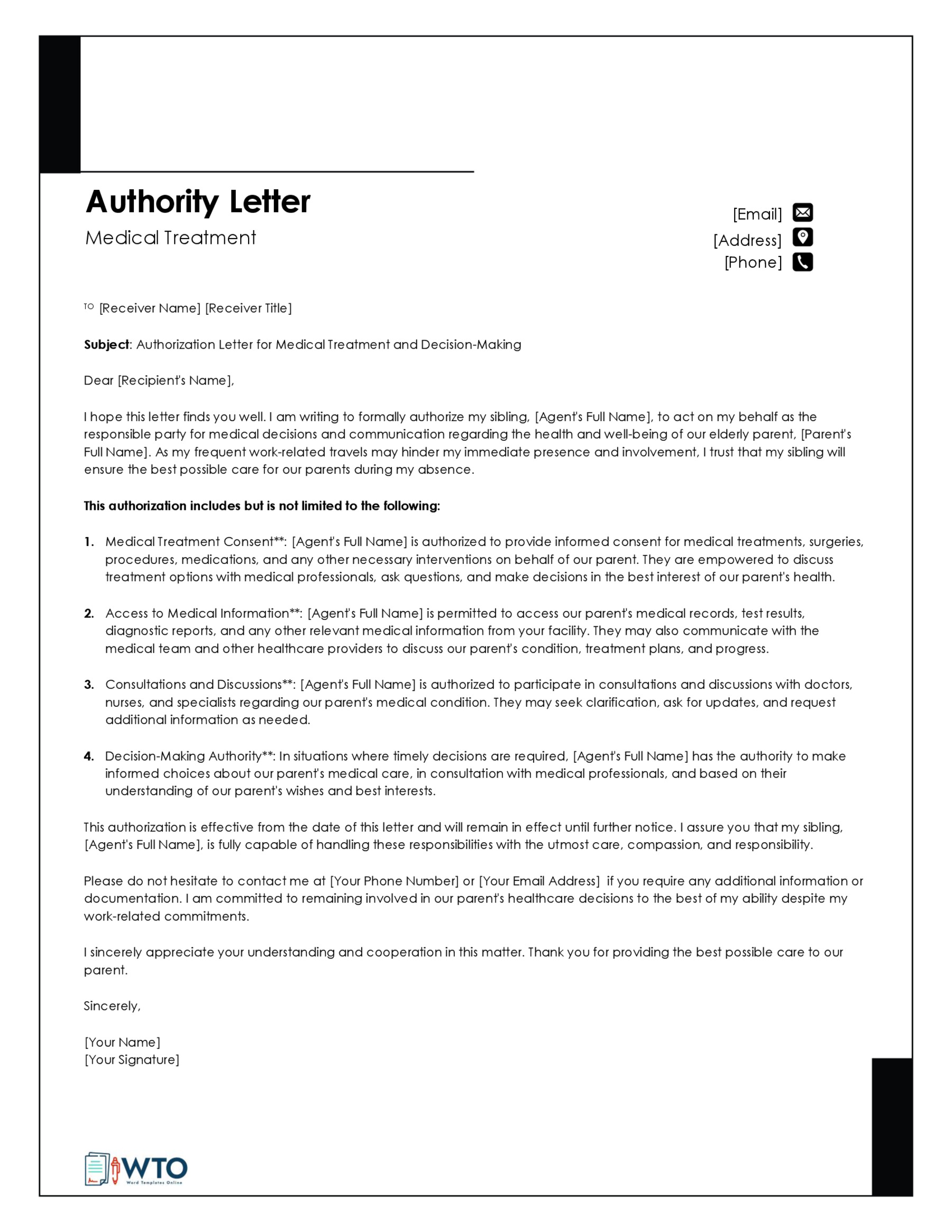
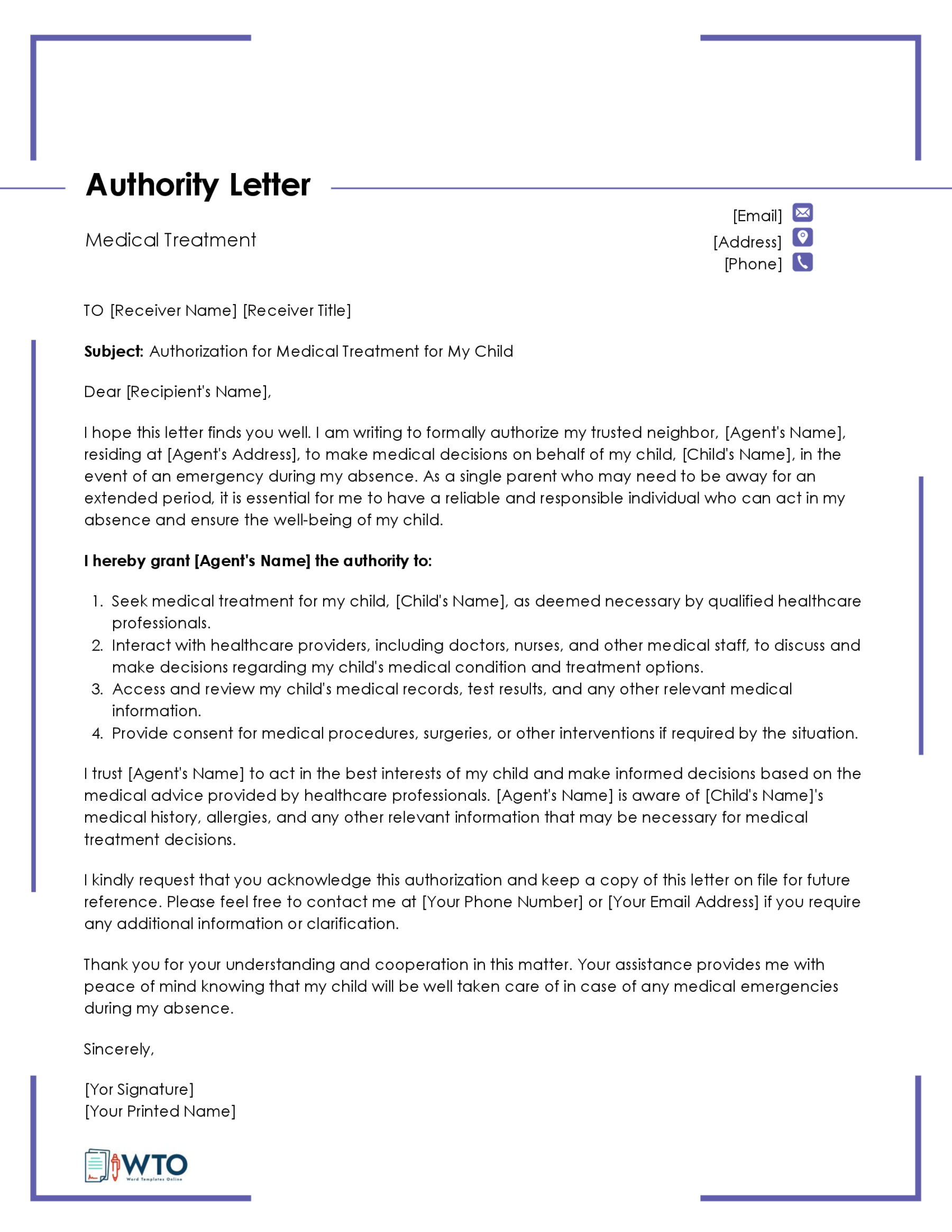
Sample Letter
In this section, you can find a helpful guide on crafting a medical authorization letter for a child, as a parent or guardian. It offers a straightforward example to assist in navigating the often-sensitive process of authorizing medical care for a minor.
Sample
Subject: Medical Authorization for Michael Doe
Dear Dr. Smith,
I, Jane Doe, am writing this letter to grant permission for necessary medical treatment for my child, Michael Doe, in my absence. This authorization is being issued due to a business trip that I must attend from January 10 to January 20, 20XX.
Michael has a known allergy to penicillin and a mild case of asthma. He requires an inhaler, which he carries with him, for the asthma.
I authorize my sister, Laura Green, residing at 789 Maple Avenue, Springfield, IL, to make any decisions regarding medical treatments or procedures that may be required during my absence. This authorization includes, but is not limited to, emergency treatments, surgical interventions, and routine medical care.
Michael is covered by HealthFirst Insurance, and the policy number is HF987654321. Please keep a copy of this letter in my child’s medical records and provide Laura Green with any necessary copies.
Please feel free to contact me directly at 555-123-4567 or janedoe@email.com if you need further information or verification regarding this authorization.
Thank you for your attention to this matter and for providing care for my child in my absence.
Sincerely,
[Signature]
Jane Doe
Analysis
This medical authorization letter for a minor is an exemplary model due to its clarity and comprehensiveness. It clearly states its purpose: to grant medical decision-making authority to an agent during the principal’s absence, with specific dates provided for context. This precision eliminates any confusion about the duration of the authorization.
The letter also meticulously includes essential medical information about the minor, such as his allergy to penicillin and asthma condition, crucial for ensuring safe and appropriate medical care. It designates a responsible adult for decision-making, providing her full details for easy verification by medical professionals. The inclusion of insurance information further streamlines any administrative processes involved in the child’s care.
Lastly, the letter is well-structured, with clear instructions regarding the handling of the authorization in medical records and contact information for any necessary follow-up. This level of detail and organization makes the letter an ideal template for anyone needing to draft a similar medical authorization.
Roles of the Parties Involved
The parties involved in the letter play distinct roles that collectively ensure the well-being and appropriate medical treatment of the patient. These roles are defined by their specific responsibilities and legal obligations within the healthcare context:
Principal
The principal is the individual responsible for drafting the letter. This could be a parent, primary caregiver, or legal guardian. The principal’s role involves granting legal authority to a designated person to make medical decisions on their behalf.
Authorized person (agent)
The authorized person, often referred to as the agent, is the individual designated by the principal to make medical decisions and oversee treatment in their absence. This person can be a family member, a close friend, or a legal guardian. Their role involves acting in the best interests of the patient, representing the principal, following the patient’s wishes if known, and making informed medical decisions.
Recipient (healthcare provider or medical institution)
A recipient is any party, individual, or entity that requests the letter before proceeding with the treatment of the patient. Examples of recipients include hospitals, clinics, doctors, nurses, medical specialists, and other medical professionals responsible for diagnosing, treating, and caring for the patient.
Step-by-Step Guide: How to Draft an Authorization Letter for Medical Treatment
Drafting the letter for medical treatment involves several steps to ensure that it accurately reflects your intentions and complies with legal and healthcare standards. Here’s a step-by-step guide to help you create an effective and well-structured letter:
Step 1: Add header
Start the letter by identifying yourself and the recipient. Write your name and address at the top left corner of the page, followed by the date when the letter was written. The date establishes a clear timeline for when the authorization was issued. Ensure that each item is placed on its own line. Then, similarly, indicate the name, title, and address of the recipient. This information ensures that the letter reaches the intended party.
EXAMPLE
Jane Doe
335 5th Charleton Street
Anycity, Anystate, 31001
(5555) 0022-9379
doejane1@email.com
August 14, 202x
Michelle Owens
Head Nurse
St. Immaculate Medical Facility
105 Crenshaw Avenue
Anycity, Anystate 28801
Step 2: Begin with a salutation
Address the recipient with a formal salutation. If you know their name, use “Dear [Recipient’s Name],” followed by a comma. If you don’t know their name, a general salutation like “To Whom It May Concern” is appropriate. A formal salutation is considered professional conduct and clarifies the recipient to whom the letter is directed. It also adds a personal touch to the letter.
Step 3: Introduce yourself and the purpose of the letter
In the opening paragraph, briefly introduce yourself and state the purpose of the letter. It must be clear that the purpose of the letter is to award authorization to the agent. Make sure to include your name and the agent’s name in your introduction.
EXAMPLE
A good introduction can be presented as follows:
I, [your name], write this letter to appoint [agent’s name] to represent and make decisions for medical treatment on my behalf.
Step 4: Provide patient details
Proceed to share essential details about the patient, such as their full name, date of birth, and any relevant medical history or conditions. You can also provide any key medical conditions or history that may influence treatment options. This information helps identify the patient and provides context for medical decisions.
EXAMPLE
This authorization letter is for treatment and medical procedures for the following individuals:
Name: James Hill
Date of Birth: August 10, 2023
Address: 444 Mildew Street, OH, USA
Medical History: The patient is allergic to NSAIDs (nonsteroidal anti-inflammatory drugs), e.g., ibuprofen. Has mild asthma. Severe cold in the last 3 months.
Step 5: Express authorization
The next step is to explicitly state that you are granting authorization for medical treatment to the named individual. The statement should include your name and the authorized representative’s full name.
EXAMPLE
You can structure the statement as follow:
I, [Your Full Name], hereby grant authorization to [Authorized Person’s Full Name] to make medical decisions and provide consent for medical treatment on my behalf.
Step 6: Specify the scope of authority
Clearly define the scope of the authorized person’s decision-making authority. Specify if they can consent to treatments, surgeries, medications, and other medical interventions. You may also mention their ability to access medical records and communicate with healthcare providers. If there are limitations to the authority, clearly outline them. Ensure that there is no ambiguity so that the agent operates in the patient’s best interests.
EXAMPLE
[Authorized Person’s Full Name] is empowered to communicate with healthcare providers, give consent for medical procedures, and surgeries, administer medications, and access medical records as necessary for my medical treatment. I trust [Authorized Person’s Full Name] to act in my best interests and make informed decisions about my healthcare.
Step 7: Define the duration
Defining the duration in a letter of authority for medical treatment refers to specifying the period during which the authorization is valid. Tailor the duration to the nature of the medical treatment. Provide clarity on when the authorization starts and when it concludes. This helps establish a well-defined timeframe.
EXAMPLE
This authorization is effective from [Start Date] and will remain in effect until [End Date] unless otherwise revoked in writing. I reserve the right to revoke this authorization at any time by providing written notice.
Step 8: Include contact information
Include your contact information to facilitate ongoing communication. Ensure that the recipient can easily reach you for any questions, concerns, or updates related to your medical condition or treatment.
EXAMPLE
I can be contacted via [Your Phone Number] or [Your Email Address] for any questions, concerns, or updates regarding my medical condition or treatment.
Step 9: Close the letter
Finally, conclude the letter by expressing your gratitude to the reader. Use a formal closing, such as “Yours Sincerely,” followed by your signature. If the letter is being sent electronically, you can type your name and include a scanned version of your signature.
EXAMPLE
Thank you for your understanding and cooperation.
Sincerely,
[Your Signature]
[Your Full Name]
Legal Considerations in Medical Authorization Letters
The letters involve important legal considerations to ensure that the authorization is valid, compliant with relevant laws, and an accurate representation of the patient’s wishes.
Here are some key legal considerations to keep in mind when crafting the letter:
Clarity and specificity
Clearly define the scope of the authorized person’s decision-making power. Be specific about the types of medical decisions they can make, treatments they can consent to, and any potential restrictions. Specificity minimizes ambiguity and ensures that the agent operates within well-defined boundaries.
Revocation clause
Include a clause indicating that the patient retains the right to revoke the authorization in writing at any point. This inclusion provides the patient with flexibility and control over the authorization’s duration and applicability.
Witnesses and notarization
Consider the legal requirements of your jurisdiction. Depending on the jurisdiction and the gravity of medical decisions being authorized, witnesses or notarization might be required to validate the authenticity of the authorization. Consult local regulations to ascertain the applicable procedures.
Compliance with regulations
The letter should comply with applicable healthcare laws and regulations. Before writing the letter, conduct thorough research to identify and understand the relevant guidelines within your jurisdiction. Adhering to these regulations ensures that the authorization is legally sound and aligns with established norms.
Informed consent
Emphasize that the authorized person must be fully informed about the patient’s medical condition, available treatment options, potential risks, and anticipated benefits. This is to ensure the agent’s decisions are based on the patient’s interests, medical history, and current condition. Informed consent is an essential principle in healthcare law.
HIPAA Regulations and Medical Authorization Letters
In addition to the above considerations, the letter must also comply with HIPAA (Health Insurance Portability and Accountability Act) guidelines/procedures to protect the privacy of the patient’s medical information.
The key HIPAA guidelines to consider include the following;
Authorization for disclosure
As per HIPAA guidelines, written authorization must be provided for a healthcare provider to disclose a patient’s medical information to a third party. This authorization is essential to ensure that the patient’s privacy is maintained and that their medical details are shared only with authorized individuals.
Minimum necessary standard
This guideline dictates that healthcare providers must follow the “minimum necessary” principle when disclosing a patient’s protected health information. Therefore, the letter should specify the information that the agent can access and the recipient can share.
Consent for treatment
The letter should use language that explicitly grants the agent authority to make decisions and consent to treatment interventions. However, this authorization must be granted while remaining compliant with HIPAA laws.
HIPAA compliance
HIPAA compliance is essential for healthcare providers and their business associates to safeguard the privacy and security of patients’ health information. When drafting a letter for medical treatment that involves Protected Health Information (PHI), it’s important to consider HIPAA compliance.
Final Thoughts
An authorization letter serves as a vital framework, allowing individuals to designate trusted agents as legal guardians or primary caregivers. The letter offers a profound solution to the complexities of decision-making in cases of absence or emergencies. By facilitating seamless coordination among healthcare providers, authorized representatives, and families, the letter not only protects the patient’s best interests but also promotes efficient and collaborative healthcare management.

